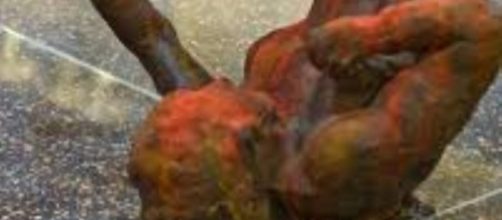A new show by artists from around the world opens at the Imperial War Museum in London Oct 28 under the banner “Age of Terror: Art Since 9/11.” Exhibit examples come in many forms - sculpture, painting, film, photography, installations and prints, but none will address terrorist bombings or knifings. As exhibit curator Sanna Moore explained to the press, the display is about what he called “the state of emergency” suffered since 9/11. Just as well. We get plenty of images of killings in the news, thank you very much.
No pictures, please
But wait, imaging the “state of emergency” doesn’t sit well, either, most especially because Moore is using 9/11 as his inflection point.
It’s probably blasphemy for an art critic to say this, but visual artists need to step back from picturing the World Trade Center horror. It’s not a picture story. There’s nothing to see because the 2.606 victims were pounded into powder when the towers collapsed, leaving nothing but pulverized concrete. Some things shouldn’t be pictured.
Object lesson
Consider what happened when Eric Fischl’s sculpture “Tumbling Woman” – an upside-down figure made look in free fall – the artist’s tribute to those on 9/11 who leaped to their death from the 110-story towers. The work was installed at Rockefeller Center, but it had to be hauled away when New Yorkers couldn’t bear the sight. There’s such a thing as being too pictorial.
If anything, you need metaphor, and when it comes to symbols, architecture has succeeded where visual art has not.
What emptiness looks like
I’m thinking of the two black holes - the towers’ footprints that architect Michael Arad created for the WTC Memorial he calls “Reflecting Absence.” With no bodies to bury, he gave us an insignia, the look of empty graves.
The chasms signify the cost of life on 9/11 when the WTC caved in. Knowledge of that leaves you hollow, and Arad set that feeling in stone. Art has no place here.
Feeling the pain
When Arad’s concept was okayed, he told me how the ruin moved him and why he didn’t want to see the towers put back. He said that replacing them seemed an attempt to pretend it didn’t happen.
“I wanted people to stand at the edge of the voids, experience those spaces surrounded by the names of those who died, and have a true memorial.”
Etched in stone
Architect, Maya Linn did a similar thing when she designed the Vietnam Veterans Memorial - a rampart of black marble imprinted with the names of those gone or unfound - partially covered up by the earth. As she has said, “I had an impulse to cut open the earth, an initial violence that in time would heal. The grass would grow back, but the cut would remain.” Those cuts in the earth by both architects are memorably constant. No pictures needed.


